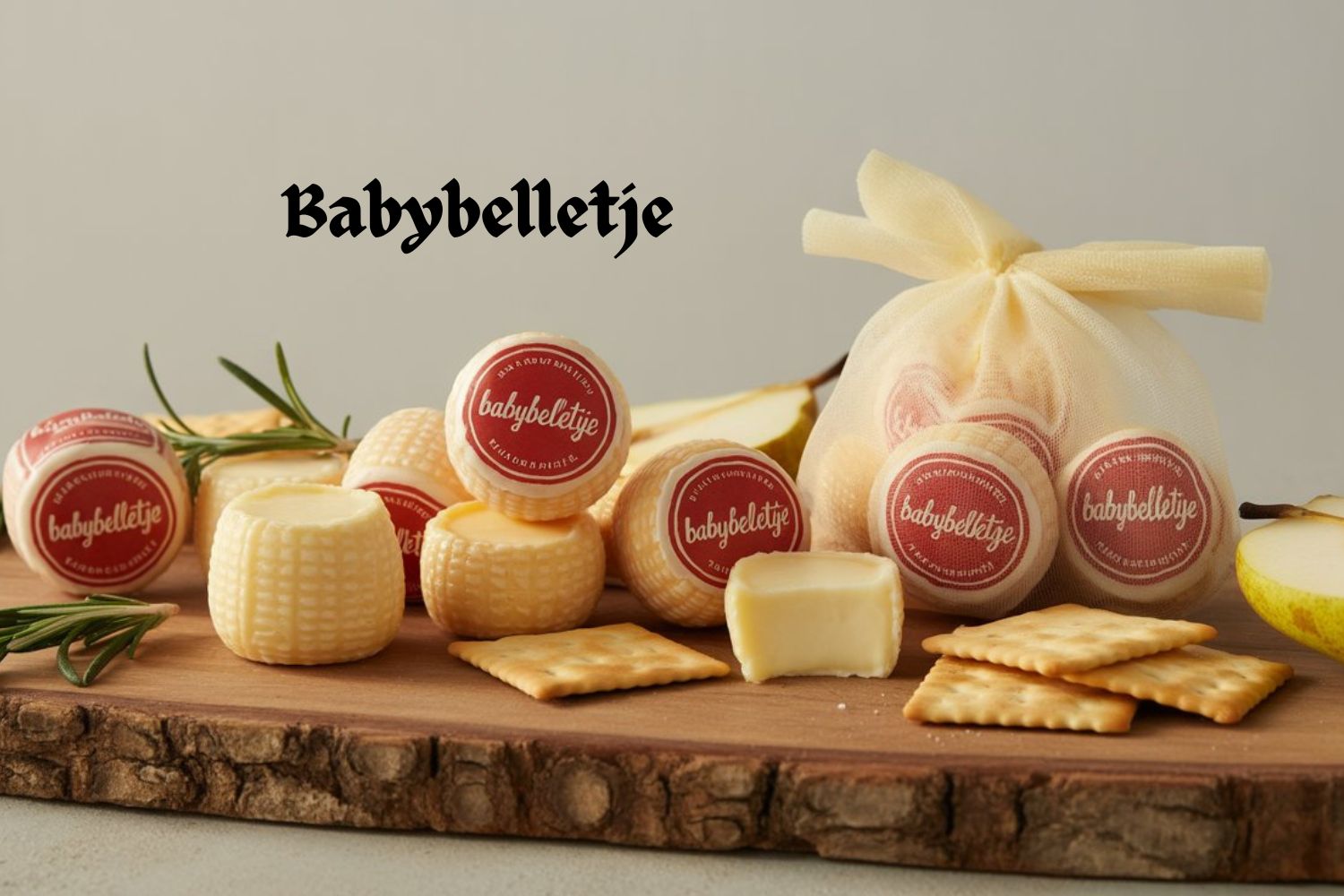Have you ever watched your little one eye that tiny red Babybel cheese and wondered, “Could they eat that?”
I’ve been there. My toddler once grabbed one straight from the fridge, proudly holding it like a treasure. That’s when I started digging into whether a babybelletje — the cute Dutch nickname for mini Babybel cheese — is really a safe choice for small kids.
If you’ve ever had that same thought, stick around. In this guide, I’ll walk you through what I’ve learned about Babybelletjes: why parents love them, when they’re safe, how to serve them properly, what’s actually inside, and even some fun ways to turn them into creative snacks. Let’s dive in.
Why Parents Are Talking About Babybelletje
It’s hard to open a lunchbox these days without spotting one. Babybelletjes have become the go-to snack for families across Europe — especially the Netherlands and Belgium.
Why? Convenience. They come in those neat red wax shells, don’t make a mess, and feel like a treat. I’ve seen parents toss them into school lunches, picnics, and even road trip bags because they’re portioned just right.
But there’s another reason parents keep searching for “babybelletje” online — they’re trying to figure out if it’s safe for little ones. Some worry about the wax coating, others about choking hazards, or whether it’s too salty for toddlers. And honestly? Those are smart questions. Because just like any “mini” food, what’s great for a 6-year-old might not be okay for a 1-year-old.
Is Babybelletje Safe for Babies and Toddlers?
Here’s what I’ve found after talking to pediatric dietitians and doing my own research. Babybel cheese itself is made from pasteurized cow’s milk, so it’s technically safe once your baby starts eating dairy — usually after 12 months.
But the real concern isn’t the ingredients; it’s the texture and size. A whole Babybel is firm, round, and slippery — a classic choking risk for children under three. So if you’re offering it to a toddler, slice it into thin pieces or small cubes.
Now, about that famous red wax. It’s made from food-safe paraffin and coloring — not toxic, but definitely not meant to be eaten. It’s a protective layer that keeps bacteria out. I always peel it completely before serving, then double-check for residue.
As for salt, Babybel contains around 180 mg per mini — not outrageous, but enough to keep portions small for younger kids. One piece a few times a week is perfectly fine.
Bottom line? A Babybelletje can be a safe, nutritious snack if you handle it right — cut, portioned, and served under supervision.
How to Serve Babybelletje Safely at Home
Let me share how I usually do it at home — and what most nutritionists recommend.
- Cut it first. Don’t hand a whole Babybel to a toddler. Slice it into thin half-moons or small cubes.
- Check the texture. If it feels too rubbery, mash it slightly with a fork for younger eaters.
- No wax bits. Always remove the wax completely — sometimes tiny flakes stick to the cheese.
- Serve chilled but soft. Straight from the fridge, Babybel can be too firm. Let it sit for 5–10 minutes so it softens a bit.
- Watch closely. Even with small pieces, keep an eye out as kids eat — that’s non-negotiable.
For storage, Babybelletjes last about a week once opened, as long as they stay refrigerated in an airtight container. I’ve noticed they hold flavor best when wrapped in a small piece of baking paper instead of plastic.
Babybelletje Nutrition Facts — Healthy or Processed?
Let’s get honest here — Babybelletjes are not superfoods, but they’re far from junk either.
Each mini round (22 g) offers about 65 calories, 4–5 grams of protein, and calcium that supports healthy bones and teeth. That’s actually quite solid for such a small snack.
The not-so-great side? Salt and fat levels are on the higher end, since it’s a semi-hard cheese. Compared to other snacks — say, crackers or chocolate bars — it’s still a much better option. But don’t make it an everyday staple for babies.
When I compared Babybel to Laughing Cow wedges and mozzarella balls, Babybel scored higher for protein but was slightly saltier. So balance is key. For school kids, it’s a smart protein boost; for babies, moderation matters.
Creative Snack and Lunch Ideas Using Babybelletje
Here’s where it gets fun. Because Babybelletjes aren’t just grab-and-go snacks — they can turn into playful, colorful meals.
1. Mini cheese wraps: Slice the cheese thin, wrap it in tortilla strips with cucumber or turkey slices.
2. Snack skewers: Alternate Babybel cubes with grapes or cherry tomatoes (for older kids).
3. Melted Babybel toasties: Press into whole-grain bread, grill lightly — kids love it.
4. Lunchbox rolls: Combine with carrot sticks and crackers for balanced texture.
5. Picnic bites: Pair Babybelletjes with apple slices — that mix of creamy and sweet is magic.
I’ve made these for weekend lunches, and they disappear fast. The key is variety — keep the plate colorful, and kids get excited to eat.
Where to Buy Babybelletje in the Netherlands & Belgium
You’ll find Babybelletjes almost everywhere — they’re a supermarket staple.
Albert Heijn, Jumbo, Lidl, and Colruyt all stock them, usually near the pre-packed cheese section. You can also grab them online from sites like Picnic or Bol.com. Prices hover between €2.50 €3.50 per 6-pack, depending on store promotions.
Watch for limited-edition flavors — I’ve seen light, bio (organic), and even goat cheese versions popping up lately. For families, the multi-packs or “Family Bag” versions give better value.
Best Alternatives to Babybelletje for Small Children
Maybe your little one has a milk allergy, or you just want to switch things up. I’ve tested a few good substitutes:
- Organic mini cheeses: Brands like Arla or BioTime offer softer options with less salt.
- String cheese or cubes: Easier to chew and portion.
- Vegan or plant-based minis: Some almond or oat-based versions mimic that creamy texture without dairy.
One of my friends swears by mini mozzarella balls soaked in mild brine — softer, gentler, and easy to mash for babies. I’ve tried them too, and they’re a great alternative when you want variety.
Final Thoughts — Smart, Safe, and Fun Snack Choices
If there’s one thing I’ve learned, it’s that babybelletjes can be both fun and healthy — if handled right.
They’re portioned perfectly, packed with calcium, and easy to love. But they’re also not “just cheese.” They’re small, round, and need care when served to little ones. So cut, peel, and supervise — always.
I’ve found that parents who approach snacks with curiosity (instead of fear) end up building better food habits for their kids. It’s not about banning foods; it’s about understanding them. And Babybelletje? It’s one of those snacks that can fit beautifully into a balanced, mindful diet.
FAQs About Babybelletje
Can I give Babybel to a 1-year-old?
Yes — but only in small, thinly sliced portions. Avoid giving a whole piece due to choking risk.
Is Babybel processed cheese?
Not quite. It’s semi-hard natural cheese made from pasteurized milk, not the melted “processed” kind.
What’s the wax made of?
It’s a mix of food-safe paraffin and microcrystalline wax. It’s non-toxic but not edible.
How long does it last after opening?
Around 5–7 days if refrigerated in a sealed container. The wax keeps it fresh longer when unopened.


